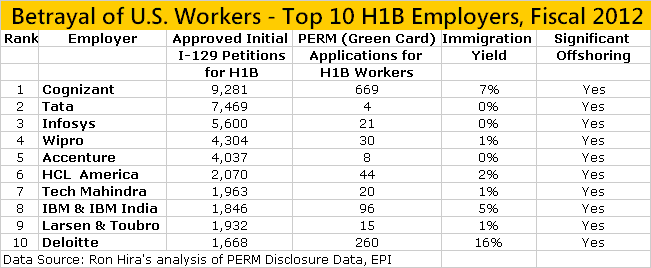Two central tenets of the H1B specialty worker Visa program are that America has a shortage of specialty workers, particularly in fields like science, technology, engineering and math (where the U.S. has been badly lagging Asian nations in recent years) and the need to get the best and brightest here to boost our nation’s competitiveness.
Not surprisingly, a big chunk of the H1B Visas issued every year goes to computer programmers, engineers and scientists.
But H1B Visas have had a devastating impact on America’s engineering and programming community who have been cast aside for lower-paid H1B workers.
Knowing that there is a deluge of H1B workers entering the country every year, fewer students are entering computer science and engineering programs in the U.S. resulting in a perverse, greater dependence on the H1B Visa program.
H1B Visa – Multiple Problems
* First, the hit on American workers because H1B workers can and are often paid less than a U.S. worker in the same occupation and locality (Source: Economic Policy Institute).
* Second, H1B Visas are just a revolving door, where guest workers come on short-term visas, learn the job, gorge on dum biryani and chowmein, feast on Allu Arjun and Jackie Chan films and take the job back to India or China.
* Third, the U.S. does not really benefit from the so-called talent of these specialty workers because very few of these H1B Visa holders get Green Cards and stay here permanently (see below table). I’d say the H1B Visa program is actually reducing American competitiveness in the global arena since the workers are picking up advanced skills in the U.S. and taking it back to their low-wage nations.
* Fourth, given the young age of a lot of the H1B workers it’s doubtful many of them come here with ‘special’ greatly needed skills. Most likely, the majority are doing basic, entry-level tasks that could easily be performed by American workers if they were given the opportunity.
* Finally, the program has led to massive Visa fraud in credentials and documentation

Bonobos in Congress – Making it Worse
One of the distressing aspects of American politics is we have bonobos in high office constantly looking to screw American workers.
For the benefit of schmucks, let me explain that bonobos are small chimpanzees with an IQ in the 35-49 range (i.e. moderately retarded).
What makes it worse is that these bonobos in Congress are also beholden to every vested interest in the nation.
Now these bonobos in Congress are planning to raise the H1B Visa quota per year from 85,000 to 300,000 (400,000 in some accounts) by way of the I-Squared Act.
We think that’s a wooly-headed move that does little good to American workers o America’s competitiveness.
If America is to really benefit from the talent pool overseas, we must issue them Green Cards in an expedited manner.
But that is unlikely to happen for two reasons – first, the balance of power is heavily in favor of the wealthy corporate patrons of the bonobos in Congress and second, the American voters are too stupid to realize they’re being screwed.

Very insightful data especially green card applications ratio for H1B visa holders.
If you are a green card aspirant and work for Tata, Satyam, Wipro, Infosys, Accenture – you are finished.
You are right that this will only benefit the corporate bosses, the rich, the one percent.
The ruling class/corporate plutocrats want cheap, obedient powerless labour who will never question them. Guest workers beholden to a company through the H1B program is very convenient for them. The worker is in a foreign land well aware that his/her stay is temporary and they can be kicked out any time and their stay in US is dependent on keeping their sponsor happy. It is a form of indentured servitude, very suited to the needs of those giving the orders. Also the local labor will not have as much bargaining power since there is the issue of imported servile workers. The theory is they don’t want to give these imported workers green cards because it will accelerate the demographic changes happening in US and increase the non Caucasian population.
The current demographic changes are already ringing major alarm bells and we can see the impact on American politics. So the compromise seems to be to bring them as guest workers tied to a company which will make them obedient to the company and then kick them out when they are not needed any more.
SearchIndia.com Responds:
Green Cards is a win for both workers and the U.S. but not for companies like Wipro, Infosys, TCS etc that want to keep workers on a tight leash!
I think the fourth point you mention is important. Majority of H1B workers do the IT industry equivalent of the Agri sectors Orange plucking, Cabbage harvesting type jobs. In a manner of speaking, Asian Indians are the IT industry Mexicans.
Let’s face it H1B visas are issued just to bridge the shortage in the labor pool. Cranking out web pages, SQL Server database administration or writing database interaction java applications are not exactly advanced scientific or technical skill. It is more in the vocational skills category not advanced technical skills. The local labor pool with high school education and a year or two of vocational training can do these tasks easy.
For America to keep attracting the best brains, the Green Card program should be put on the express lane but a very discriminating express lane. Anyone with credited with creation of significant intellectual capital should be on this express lane.
And for the folks who take up employment with any of these companies for doing run of the mill IT jobs, they should take it for what is and make the most of it. They are being employed to bridge the gap in the labor pool. That’s all there is to it.
SearchIndia.com Responds:
You write: In a manner of speaking, Asian Indians are the IT industry Mexicans.
Very true but I fear the morons in Congress are either too dumb or bought off by the lobbyists to make the distinction! For these jackasses, anyone who can mouth the word “Java” is a specialty worker. 🙁
Off-topic:
Not sure if you’ll be able to read this tamil piece, still..
http://tamil.oneindia.in/news/2013/02/21/tamilnadu-jaya-s-chepaer-rate-food-canteens-get-thumps-up-170234.html
http://www.indianexpress.com/news/idli-for-re-1-jayalalithaa-dishes-out-budget-canteens-in-tamil-nadu/1076892/0
SearchIndia.com Responds:
Please review one of those Budget Canteens (15 are already open in Chennai)for SI by eating everything on offer there.
SI readers would dearly love to read the perspective of a Tamil IT Worker on the food of a Tamil Daily Wage Worker. 😉
We look forward to your comprehensive, perspicacious review with deep insights on the menu, ambiance, quality, quantity, your fellow diners etc at the Budget Canteen.
When you’re eating in one of those Budget Canteens, we’d like to you engage in discussion with your fellow Budget Diners (daily wage laborers) and ask their views on subjects that preoccupy IT workers, stuff like iPhone/iOS vs Android/Google, does Yahoo have a future, the prospects for Ubuntu on smartphones and tablets, Windows 8, Bing, decline of PCs/Notebooks and growth in tablet computing etc.
We do look forward to reading your enlightening review on the Budget Canteen in a day or two.
If you have any doubts, you may contact me via e-mail or as they say in India, Proper Channel! 😉
Another thing:
Not sure if this is a meaningful action, yet, a bold one.
http://www.thehindu.com/news/national/tamil-nadu/tamil-nadu-not-to-host-asian-athletics-games-jayalalithaa/article4438291.ece
SearchIndia.com Responds:
Thank God! The reputation of Tamil Nadu is saved.
We know what a wonderful job Delhi did with the 2010 Commonwealth Games.
@BoopalanJ:
Not sure if you’ll be able to read this tamil piece, still..
http://tamil.oneindia.in/news/2013/02/21/tamilnadu-jaya-s-chepaer-rate-food-canteens-get-thumps-up-170234.html
One of those rare good schemes that she has introduced in TN. Considering the rising rate of inflation and decreasing wages, the poor and lower-middle classes will really benefit from this.
Hopefully, these tiffin centres remain functional throughout the year…. and do yeoman service.
SearchIndia.com Responds:
A very good move, if implemented well.
My feeling is that there will be resistance from other restaurants if the response proves too strong to these Tiffin Centres.
SI said:”My feeling is that there will be resistance from other restaurants if the response proves too strong to these Tiffin Centres”
True indeed. All the small restaurants, tiffen centres, and tea shops (Yes, tea shops have been providing tiffen items and lunches in Chennai, without a valid hotel license, for years now) will now be affected. But there is a big “IF” here. The CM has promised 200+ centres, but for a vast city like Chennai, 200 is a very small number, especially considering that Chennai is now expanding its limits till Urapakkam, Guduvanchery, and perhaps Chengelpet in the South and Tiruvallur (Quite a Possibility) in the North…
Also, even in the small restaurants at Chennai, basic items like Idli, Vada, Pongal, Puri, and Coffee are priced at costlier rates. Please find the rates as follows (Please note that these are the rates in small shops, not hotels like Adyar Ananda Bhavan, Sangeetha, Saravana, or Vasantha Bhavan)
Idli: 10-15 INR for 2 pieces (Minimum rate 10 rupees for 2 pieces)
Vada: 6-10 INR for 1 piece (Some tea shops sell it for 4 rupees a piece, but the majority sell at around 5-6 rupees per piece)
Pongal: 15-20 INR for 1 plate – 100-150 grams (Small tiffen shops sell it around 18-20)
Puri – 10-20 INR for 2 pieces (Puri has a huge variation in price, one tea shop/tiffin centre sells it for 12 INR, while the other may sell it for 20)
I am yet to know the prices of these items in the Government tiffin centres. But considering the inflation, I am sure they can only give a discount of 1-2 rupees per item, which itself will be a boon for the deprived.
I will try to visit one such tiffin store and get the details….. Let me see if any tiffin centre has opened in and around Chrompet, Tambaram, Pallavaram.
SearchIndia.com Responds:
Awesome! 🙂
Please take lot of pictures (food and external picture of tiffin center) when you go there and talk to your fellow diners and find out what they think of Amma’s gesture to start these centers.
But strike when the iron is hot!
I do not have the advantage of observing this from close quarters. Maybe these canteens will get their raw materials through the PDS system a.k.a ‘ration store’. That could make them very cost competitive.
I have heard that the government also runs a cable TV operation, providing subsidized cable TV.
Maybe this is an effort with similar noble intentions, hope it works out ok. Also hoping that they keep hygiene levels better than the ‘Kai-yendhi’ bhavans.